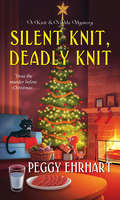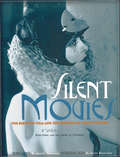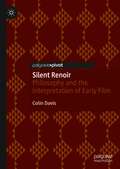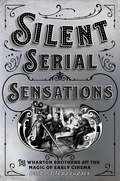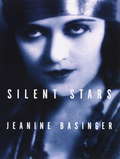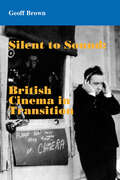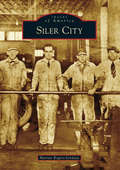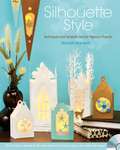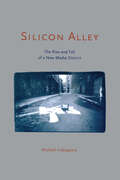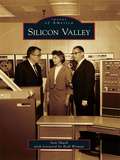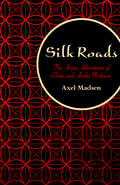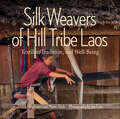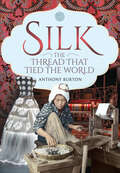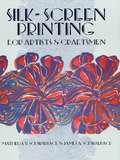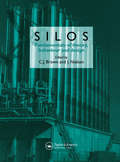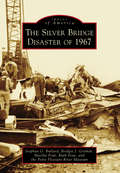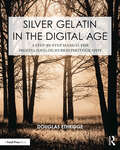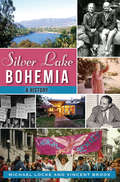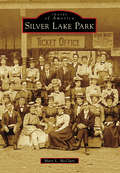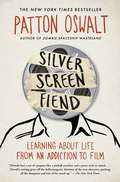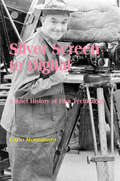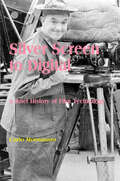- Table View
- List View
Silent Knit, Deadly Knit (A Knit & Nibble Mystery #4)
by Peggy EhrhartWhen murder silences the Christmas cheer in charming Arborville, New Jersey, Pamela and her Knit and Nibble pals must unravel the most bone-chilling mystery this side of the North Pole . . . Pamela has been in merry spirits since her artsy daughter Penny returned home from college for the holidays. But their mother-daughter bonding time gets cut short when a terrified Penny stumbles upon the dumped body of Millicent Farthingale, a wealthy craft shop owner who was popular for all the wrong reasons. From a scheming business partner to a seedy husband several years her junior, Millicent attracted scammers so in love with her assets, they’d toss her down a chimney to get their paws on them. Now, with only a hand-knit red scarf connecting the killer to the crime, Pamela and the Knit and Nibblers could use some extra creativity as they find out who’s really naughty or nice in Arborville—because going up against a looming culprit is DIY or die! Knitting tips and delicious recipe included!
Silent Movies: The Birth of Film and the Triumph of Movie Culture
by Peter Kobel Martin Scorsese Kevin BrownlowA gorgeous, lavish history of silent movies - with more than 400 amazing images - captures the birth of film and icons like Chaplin, Garbo, Clara Bow, and Valentino. Drawing on the extraordinary collection of The Library of Congress, one of the greatest repositories for silent film and memorabilia, Peter Kobel has created the definitive visual history of silent film. From its birth in the 1890s, with the earliest narrative shorts, through the brilliant full-length features of the 1920s, SILENT MOVIES captures the greatest directors and actors and their immortal films. SILENT MOVIES also looks at the technology of early film, the use of color photography, and the restoration work being spearheaded by some of Hollywood's most important directors, such as Martin Scorsese and Francis Ford Coppola. Richly illustrated from the Library of Congress's extensive collection of posters, paper prints, film stills, and memorabilia-most of which have never been in print-SILENT MOVIES is an important work of history that will also be a sought-after gift book for all lovers of film.
Silent Renoir: Philosophy and the Interpretation of Early Film
by Colin DavisJean Renoir (1894-1979) is widely regarded as one of the most distinguished directors in the history of world cinema. In the 1930s he directed a string of films which stretched the formal, intellectual, political and aesthetic boundaries of the art form, including works such as Le Crime de Monsieur Lange, La Grande Illusion, La Bête humaine and La Règle du jeu. However, the great director’s early work from the 1920s remains almost completely unknown, even to film specialists. If it is discussed at all, it is often seen to be of interest only insofar as it anticipates themes and techniques perfected in the later masterpieces. Renoir’s films of the 1920s were sometimes unfinished, commercially unsuccessful, or unreleased at the time of their production. This book argues that to regard them merely as prefigurations of later achievements entails a failure to view them on their own terms, as searching, unsettled experiments in the meaning and potential of film art.
Silent Serial Sensations: The Wharton Brothers and the Magic of Early Cinema
by Barbara Tepa LupackThe first book-length study of pioneering and prolific filmmakers Ted and Leo Wharton, Silent Serial Sensations offers a fascinating account of the dynamic early film industry. As Barbara Tepa Lupack demonstrates, the Wharton brothers were behind some of the most profitable and influential productions of the era, including The Exploits of Elaine and The Mysteries of Myra, which starred such popular performers as Pearl White, Irene Castle, Francis X. Bushman, and Lionel Barrymore. Working from the independent film studio they established in Ithaca, New York, Ted and Leo turned their adopted town into "Hollywood on Cayuga." By interweaving contemporary events and incorporating technological and scientific innovations, the Whartons expanded the possibilities of the popular serial motion picture and defined many of its conventions. A number of the sensational techniques and character types they introduced are still being employed by directors and producers a century later.
Silent Stars
by Jeanine BasingerFrom one of America's most renowned film scholars: a revelatory, perceptive, and highly readable look at the greatest silent film stars -- not those few who are fully appreciated and understood, like Chaplin, Keaton, Gish, and Garbo, but those who have been misperceived, unfairly dismissed, or forgotten. Here is Valentino, "the Sheik," who was hardly the effeminate lounge lizard he's been branded as; Mary Pickford, who couldn't have been further from the adorable little creature with golden ringlets that was her film persona; Marion Davies, unfairly pilloried in Citizen Kane; the original "Phantom" and "Hunchback," Lon Chaney; the beautiful Talmadge sisters, Norma and Constance. Here are the great divas, Pola Negri and Gloria Swanson; the great flappers, Colleen Moore and Clara Bow; the great cowboys, William S. Hart and Tom Mix; and the great lover, John Gilbert. Here, too, is the quintessential slapstick comedienne, Mabel Normand, with her Keystone Kops; the quintessential all-American hero, Douglas Fairbanks; and, of course, the quintessential all-American dog, Rin-Tin-Tin.This is the first book to anatomize the major silent players, reconstruct their careers, and give us a sense of what those films, those stars, and that Hollywood were all about. An absolutely essential text for anyone seriously interested in movies, and, with more than three hundred photographs, as much a treat to look at as it is to read.
Silent to Sound: British Cinema in Transition
by Geoff BrownSilent cinema was never silent. But from the mid-1920s onwards, the 'sound' part of the cinema experience was transformed by the arrival of films, long and short, with clearly audible talk, music, and sound effects built in. It marked the most fundamental shift in cinema technology since cinema's birth. The first book devoted to Britain's conversion to talkies, and the result of eight years' research, Silent to Sound: British Cinema in Transition takes a lively and comprehensive look at the production side of the British sound revolution, stretching from experimental efforts in the late 19th century, through the sound shorts of the 1920s, to the key year of 1929, the year of Hitchcock's Blackmail (Britain's first home-grown talkie feature), and the industry turmoil that followed. The narrative concludes in 1934, when John Grierson's GPO Film Unit finally acquired sound equipment, prompting a late burst of experimentation just when commercial feature soundtracks had settled down. Films familiar, neglected, and unknown are examined: overripe melodramas (the lost Black Waters), local versions of Hollywood musicals (Harmony Heaven), visually elaborate science-fiction (High Treason), plus newsreels, documentaries, amateur films, and the last phase of British silent production. The impact of sound on studio technique is examined, along with the industry's complex relations with Britain's strong theatre traditions, with Europe, and above all, cinema's superpower, America. It's also never forgotten that the sound transition was shaped not just by technology but by the talents, foibles, and follies of individual people. Film history with a human face.
Siler City
by Marian Rogers-LindsaySiler City is located in the piedmont region of North Carolina, on the western side of Chatham County. The railroad first ran through the area in 1884, and the community was officially established in 1887. Blacksmith shops, livery stables, cotton gins, and sawmills were early resources that attracted trade. Lumber mills, furniture manufacturers, and a yarn plant came to town and supported its early industrialization. In 1972, Frances Bavier, better known as "Aunt Bee" from The Andy Griffith Show, retired from acting and bought a house in Siler City, where she lived the remainder of her days. Today, Siler City is a unique town that offers local residents and visitors a variety of activities, including an active artist community, Mount Vernon Springs, parks, and local sporting events at area high schools. Through this collection of historical photographs, Siler City showcases the rich industrial, commercial, and communal history of this small Southern town.
Silhouette Style
by Nanetta BanatoDiscover the modern versatility of the classic silhouette. The bold lines and strong contrasts of the silhouette are no longer limited to flat, two-color portraits to be hung on the family room wall. In Silhouette Style, silhouette designs take on color, dimension and the 21st Century. Nanetta Bananto teaches you to bring papercuts to life in more than 40 projects incorporating her beautiful, original designs. Create tea-light lanterns, gift boxes, cards, paper dolls and fashion accessories using papercut designs in themes such as sea life, animals, flowers and fashion. The book includes: Step-by-step instructions for 21 stylish projects and more than 20 variations easily created using the same techniques and designs Tips and techniques on how to cut designs either by hand or using an electronic die-cutting machine A CD-ROM containing all of the cutting design files needed to create the projects, plus bonus designs to expand your creative possibilities Pull out your scissors or electronic cutter and develop a passion for silhouettes as you create art, gifts, home décor and more! To read the pdf files on the CD-ROM included in this book, you will need Adobe Acrobat. To read .eps files, you will need a software program such as Adobe Photoshop or CorelDRAW. You may need to convert .eps files to the correct format for your cutting machine, according to the machine manufacturer's instructions.
Silicon Alley: The Rise and Fall of a New Media District (Cultural Spaces)
by Michael IndergaardThe 1990s dawned with a belief that the digital revolution would radically transform our traditional notion of cities as places of commerce and industry. Many predicted that digital technology would render cities--or at least their economies--obsolete. Instead, precisely the opposite happened. The IT-intensive firms of the new economy needed to be plugged into a sizeable network of talent, something that established cities like New York and San Francisco provided in abundance. In addition to creating new types of jobs and luring thousands of workers back into the city, new media districts created a new technobohemian urban culture. With vignettes of the high-rollers in New York's new media economy and stories of wild parties in downtown lofts, Michael Indergaard introduces us to the players in this new economy, and explores this intersection of commerce and culture in 1990s New York. He also reveals how the dot-com crash laid bare the hidden connections between the so-called new economy of new media, and the ages old engines of New York wealth: real estate speculators and Wall Street. Chronicling the go-go years and ultimate crash of the new media district, Silicon Alley is a brilliant account of how hype forged a marriage of technology and finance, which in turn generated a new urban culture.
Silicon Valley
by Sam Shueh Beth WymanNestled at the south end of San Francisco Bay, there lies a fertile valley. Cradled by the ancient Diablo and Santa Cruz Mountain ranges, the region spans much of the Santa Clara Valley, curling north from Menlo Park into Palo Alto. At its eastern gateway lies Milpitas and in the south is the Evergreen area, in the shadow of Mount Hamilton. The heart of the valley is San Jose. For many years, each spring, fruit trees produced flower blossoms as far as the eye could see. After World War II, veterans returned home, attended local engineering schools, and quickly became engaged in electronics and aeronautics development. The discovery of semiconductors and computer and Internet technologies radically altered the area, sped its momentum, and earned it its title--the Silicon Valley--now arguably the world's preeminent center for technological advances. Like the seismic waves that created the region, the valley's economic peaks and plunges have shaped the lives of its residents, but they continue to look to the future, developing new technologies to advance mankind.
Silk Roads
by Axel MadsenOne of the greatest art theft stories of the 20th century: André Malraux, French novelist, art theorist, and eventually France's Minister of Cultural Affairs, and his wife, Clara, traveled to Cambodia in 1923, planning to steal and smuggle artifacts out of the country and sell them in America. The Cambodian treasure hunt promised to be a mix of cultural sleuthing for important antiquities and risk-taking on the fuzzy edge of the laws that governed historical sites. The jungle expedition ended in arrest and, for André, trial and conviction. But it also led to a second Asian venture: the launching of a Saigon newspaper, L'Indochine, dedicated to the aspirations of the indigenous population. Madsen follows the couple from this fateful adventure that so shaped their future to the end of their marriage, and after.
Silk Weavers of Hill Tribe Laos: Textiles, Tradition, and Well-Being
by Joshua Hirschstein Maren BeckWinner, Gold Medal in the Travel Category, 2018 IBPA Benjamin Franklin Awards Part travelogue, part silk-weaving primer, this is a tender portrait of an American family's travels in Laos's Houaphon Province. As they learn about the ancient silk weaving traditions in the hilltribe community of Xam Tai, they gain an appreciation for the strong sense of well-being in Lao culture. Over the past decade, Hirschstein and Beck have developed deep connections with the villagers of Xam Tai who raise their own fiber from silkworms, dye it using local natural dyes, and weave the patterns of their ancestors into healing cloths, ceremonial textiles, and daily wear.
Silk, the Thread that Tied the World
by Anthony BurtonOver a thousand years ago the Chinese discovered that the slender filaments that formed the cocoon of the silk moth, could be woven into beautiful shimmering fabrics. For centuries they were able to keep the process a secret, but eventually started to trade the valuable cloth with the west, along the silk road. Silk was a luxury item that bestowed prestige, so it was inevitable that the wealthy wanted their silks to be as elaborate as possible, beautiful designs were produced in the Islamic world and gradually a European industry developed. In the 19th century mechanization of the time consuming hand weaving process, had resulted in products being produced using the Jacquard loom, which used punched cards to create a pattern. Silk remains the most beautiful woven material in the world, moving from its origins in ancient China to help transform the whole world.
Silk-Screen Printing for Artists and Craftsmen
by Mathilda V. SchwalbachScreen printing is simple enough for a child or beginner, but it is also a favorite printing process of experienced artists and craftspeople. It allows for a wide range of creative possibilities. It is less inhibiting than other printing processes. And, contrary to most other methods of printing, it does not require the user to make the mental translations of a reversed image.The extreme versatility of the medium has opened completely new possibilities for design and expression in both serigraphy (art prints) and textile designs. The Schwalbachs' book clearly explains how to employ silk-screen printing in both of these areas: producing a serigraph and making a fabric print. It also sets down all of the steps involved in constructing a printing board and frame, keying the screen, preparing inks or dyes, and printing the color runs -- plus a list of various problems that might turn up and their solutions.Other facets discussed include the best ways of cleaning up, handling the completed print, and working with different resists -- paper, blockout, washout, photo-emulsion. There is even a special print project for the beginner, using a cardboard frame and school tempera paint. Nearly 200 diagrams and photographs, including 19 in full color, make a clear text even clearer and offer examples of completed prints.The Schwalbachs taught silk-screen printing for many years at the University of Wisconsin. They know how to communicate the essence of this craft in the best manner possible. With their book as a guide, anyone can quickly master the techniques of silk-screening printing.
Silos: Fundamentals of Theory, Behaviour and Design
by J. Nielsen C. J. BrownBringing together the leading European expertise in behaviour and design of silos, this important new book is an essential reference source for all concerned with current problems and developments in silo technology. Silos are used in an enormous range of industries and the handling characteristics of many industrial materials require different app
Silver Bridge Disaster of 1967, The
by Bridget J. Gromek Ruth Fout Martha Fout Stephan G. BullardPoint Pleasant's Silver Bridge, the first eyebar suspension bridge in the United States, was an engineering marvel when it was constructed in 1927 and 1928. Located on US Highway 35, the bridge spanned the Ohio River and linked Point Pleasant, West Virginia, with the towns of Kanauga and Gallipolis, Ohio. For almost 40 years, the structure provided dependable service for travelers in the region. On December 15, 1967, this service came to a dramatic and disastrous end. At 4:58 p.m., during the height of rush hour, the bridge suddenly collapsed. Rescue and recovery operations started immediately but were hampered by poor weather conditions and freezing rain. The cause of the collapse was linked to the bridge's innovative design. Undetected corrosion stress cracks caused an eyebar on the Ohio side to fracture; because the eyebars were linked together in a chain, the failure of one led to the catastrophic collapse of the entire bridge. In total, 46 lives were lost in the disaster.
Silver Gelatin In the Digital Age: A Step-by-Step Manual for Digital/Analog Hybrid Photography (Contemporary Practices in Alternative Process Photography)
by Douglas EthridgeThis book provides photographers of all skill levels with a concise step-by-step guide to combining analog and digital tools with the goal of making silver gelatin prints in the traditional darkroom. It offers the most comprehensive treatment of lith printing published in many years, focusing on materials which are currently available. Key topics include traditional silver gelatin printing, direct and second-pass lith printing, film to digital image conversion, bleaching, toning and other post-production practices. Readers will learn how to use specific Photoshop tools to carry out the time-honored techniques of overall tonal control, contrast, and burning and dodging. This also features Photoshop basics for black and white, image shaping in Photoshop, and digital negative creation. Through exploring these skills, readers will gain an understanding of how to prepare images and create negatives that can be used in other historical processes including cyanotype, platinum/palladium, and many others. Author Douglas Ethridge details a systematic approach to combining analog and digital working methods, making the text ideal for both digital photographers looking to creatively edit their images with traditional darkroom aesthetics, and film photographers looking to incorporate digital capabilities into their practice
Silver Lake Bohemia: A History (American Chronicles)
by Michael Locke Vincent BrookSince the early 1900s, Silver Lake has been a magnet for iconoclastic writers, architects and political activists. Famed architect Frank Lloyd Wright, who designed the Hollyhock House for socialist and oil heiress Aline Barnsdall, drew a wave of visionary modernists to the area. Local civil rights advocate Loren Miller spearheaded the fight against housing discrimination. Silver Lake's Black Cat bar and Harry Hay's Mattachine Society were central to the early gay rights movement. Literary artists Anäis Nin and James Leo Herlihy made the neighborhood their home, as did other notables like first lady of baseball Effa Manley and "Hobo Millionaire" James Eads How. Michael Locke and Vincent Brook chronicle these and other people and places that helped make Silver Lake the bohemian epicenter of Los Angeles.
Silver Lake Park
by Mary L. McclureFrom modest beginnings as a local swimming and fishing spot, Silver Lake Park, established by Ralph H. Lodge in the 1870s, quickly grew to become one of northeast Ohio's most popular amusement parks. Thanks to its many exciting offerings, which included two roller coasters, a miniature railway, a merry-go-round, a dance pavilion, water toboggans, steamboat rides, live animal exhibits, and many other unique features, the park attracted up to 10,000 to 20,000 visitors a day from across Ohio and surrounding states. Always anxious to add new and thrilling attractions to the park, the Lodge family also introduced features described as the first public aquarium in the state of Ohio and the first aviation field in Summit County. In later years, the park added a popular Chautauqua, bringing the leading musical acts, entertainers, and orators of the day to the community.
Silver Screen Fiend: Learning About Life from an Addiction to Film
by Patton OswaltThe instant New York Times bestseller from author, comedian and actor Patton Oswalt, a “heartfelt and hilarious” (USA TODAY) memoir about coming of age as a performer during the late 1990s while obsessively watching classic films at a legendary theater in Los Angeles. “[Oswalt has] a set of synapses like a pinball machine and a prose style to match” (The New York Times).Between 1995 and 1999, Patton Oswalt lived with an unshakable addiction. It wasn’t drugs, alcohol, or sex: it was film. After moving to Los Angeles, Oswalt became a huge film buff (or as he calls it, a sprocket fiend), absorbing classics, cult hits, and new releases at the famous New Beverly Cinema. Silver screen celluloid became Patton’s life schoolbook, informing his notion of acting, writing, comedy, and relationships. Set in the nascent days of LA’s alternative comedy scene, Silver Screen Fiend chronicles Oswalt’s journey from fledgling stand-up comedian to self-assured sitcom actor, with the colorful New Beverly collective and a cast of now-notable young comedians supporting him all along the way. “Clever and readable...Oswalt’s encyclopedic knowledge and frothing enthusiasm for films (from sleek noir classics, to gory B movies, to cliché-riddled independents, to big empty blockbusters) is relentlessly present, whirring in the background like a projector” (The Boston Globe). More than a memoir, this is “a love song to the silver screen” (Paste Magazine).
Silver Screen to Digital: A Brief History of Film Technology
by Carlo MontanaroAn era has ended. After one hundred and twenty-five years, a change has taken place in cinemas. The thousands of figures formed by silver and coloured pigments can no longer be viewed through transparent film, instead, everything has become digital, compressed, virtual and built into the rapid alternation of millions (hopefully, for quality's sake) of dots, or pixels within a very neat and minuscule grid. But projection is just the last link in a chain that is transforming the most direct language invented by humanity over the centuries. The other links – shooting, editing, special effects, re-elaboration and sound reproduction – have by now undergone radical transformations that have often signified progress.Perhaps, it is worth the trouble, then, having accepted this transformation-revolution once and for all, to understand where we started out from, how cinematographic language was born and how its grammar first and later its syntax evolved thanks to technological development. Without lightweight equipment for sound recording, sensitive emulsions, portable and compact lighting, it would not have been possible, at the end of the 50s, for example, to create identifiable "currents" of experimentation and concept under such titles as free cinema or nouvelle vague, which were largely based on footage from life and no longer reconstructed in the studio. That which filmmakers today can achieve even more effectively thanks to a range of digital technologies, paradoxically, involves working with even more-minimal equipment such as a smartphone in front of green or blue screens, against absolutely virtual backgrounds. In short: no more silver and more and more pixels.
Silver Screen to Digital: A Brief History of Film Technology
by Carlo MontanaroA history of transformations in moviemaking technology, from pigments to pixels, celluloid to CGI.An era has ended. After one hundred and twenty-five years, a change has taken place in cinemas. The thousands of figures formed by silver and colored pigments can no longer be viewed through transparent film—instead, everything has become digital, compressed, virtual and built into the rapid alternation of millions (hopefully, for quality’s sake) of dots, or pixels within a very neat and minuscule grid.But projection is just the last link in a chain that is transforming the most direct language invented by humanity over the centuries. The other links—shooting, editing, special effects, re-elaboration and sound reproduction—have by now undergone radical transformations that have often signified progress. Perhaps it is worth the trouble, then, having accepted this transformation-revolution once and for all, to understand where we started out from, how cinematographic language was born, and how its grammar first and later its syntax evolved thanks to technological development.Without lightweight equipment for sound recording, sensitive emulsions, and portable and compact lighting, it would not have been possible, at the end of the fifties, for example, to create identifiable “currents” of experimentation and concept under such titles as free cinema or nouvelle vague, which were largely based on footage from life and no longer reconstructed in the studio. That which filmmakers today can achieve even more effectively thanks to a range of digital technologies, paradoxically, involves working with even more-minimal equipment such as a smartphone in front of green or blue screens, against absolutely virtual backgrounds. In short: no more silver and more and more pixels. This volume journeys through the history of cinema, focusing on the machines and mechanisms that contributed to the magic.
Silver Soldering Simplified: A New Jewelry Technique You Can Do at Home
by Scott David PlumleePopular jewelry designer and instructor Scott David Plumlee shows readers how to create 24 intricate-looking earrings, bracelets, and necklaces at home with a new quick and easy soldering technique. An innovative new material is turning traditional soldering upside down. Scott David Plumlee, author of Handcrafting Chain and Bead Jewelry, teaches jewelry makers how to use a revolutionary new soldering paste and a small hand-held butane torch to create a range of seemingly complex but easily doable chain and bead designs at their kitchen table--no elaborate, expensive studio required. Scott's ingenious methods, clear instruction, and inspiring designs will give any aspiring jewelry maker the confidence to master this formerly intimidating technique.
Silver Spring Township (Images of America)
by Christine Clepper Musser Senator Patricia VanceEstablished in 1757, Silver Spring Township is the fourth-oldest township in Cumberland County. The area was founded by the Scots-Irish, who cleared the area for farming and built taverns, inns, and mercantile businesses. Eventually, the villages of Hogestown and New Kingstown were established; these two villages are still home to many township residents. Rich in history, Silver Spring is home to the Silver Spring Presbyterian Church, the oldest church west of the Susquehanna River. Between 2012 and 2013, Silver Spring Township was the fourth-largest growing township in Pennsylvania. What were once heavily traveled Native American trails have become well-traveled highways and byways, and within a few hours, travelers can be in New York City, Philadelphia, Baltimore, and Washington, DC. Through vintage photographs, Silver Spring Township shares and celebrates the history of this well-preserved community.
Silver Surfers
by Neil PeartThe late Neil Peart, legendary drummer for the iconic rock band Rush, shares one last love letter to his beloved classic car collection and gives readers a glimpse of his lifelong passion for cars in this extraordinary collection.For Neil Peart, legendary drummer for Rush, cars were a lifelong passion. Now, in Neil's final work—a never-before-seen piece completed before his untimely passing in 2020—he writes about his beloved Silver Surfers collection; the joy of collecting these exquisite, rare, and important sports cars, and the even bigger joy of driving them. He first traces the roots of his auto obsession, taking us back to where it all began, with a 1969 Lotus Europa; through the cars he bought when the band first made it big and even his first &“family car,&” before taking us on a tour of the Silver Surfers themselves—a rare collection of the best sports cars from the 1960s. From a 1964 Aston Martin DB5 to a classic 1963 Chevrolet Corvette Sting Ray, each is a gorgeous silver (with the exception of one: a black 1964 Shelby Cobra whose patina Neil loved so much he wrote, &“I am not going to paint it&”). Gorgeous images of the cars and photos curated by Neil himself accompany his warm, personal story of building the collection, the friends he made along the way, and what it was like to be behind the wheel of these classics. Neil&’s final work is a love letter to these cars that meant so much to him, and to the passion of the road that fueled his life.
